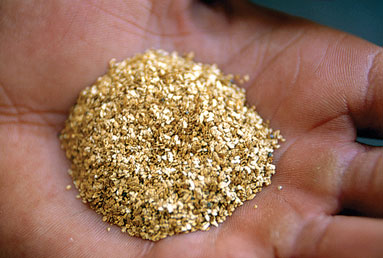Accelerator applications: Mining
Mining with light
 |
| Can light sources find a better way of extracting gold from ore? Photo: Michael Melford |
Mining involves a lot of what you might call bucket chemistry: mine workers grind up ore and put it in a vat of acid to dissolve the metal. They might add cyanide or a detergent-like chemical that bonds with the metal and draws it out of the solution, so it can be refined and purified.
The devil is in the details. For instance, if certain minerals are present, they form deposits on the surface of gold that keep it from dissolving, says Allen Pratt, a surface chemist with the mining branch of Natural Resources Canada.
Miners sometimes add lead nitrate to prevent this and speed things along. But is there a way to fine-tune the process to get more metal out of the ore?
For that, Pratt turns to a technology born in particle accelerator research-the synchrotron lightsource.
Lightsources are circular particle accelerators that generate intense beams of light for examining all kinds of materials in fine detail; think of them as microscopes on steroids. One big advantage they have over microscopes is that there is no need to slice samples thin or alter them in any way. This ability makes lightsources perfect for the kinds of analysis done in mining. We literally pick the sticks and leaves out of samples of ore or mine waste, and theyre ready to go, says Jeffrey Cutler, director of industrial science at the Canadian Light Source.
Whats more, Pratt says, researchers can tune the lightsource beam to penetrate a sample at specific depths without destroying it. Its quite beautiful, really, he says, and you can start to bring out some of the subtleties in these surface layers that cant be seen with other lab techniques.
As these processes become more efficient and metal prices go up, it may become worthwhile to go back to piles of old mine waste and extract small amounts of metal, so-called invisible gold, that were left behind, Cutler says. This metal is no longer in its original form; processing has tied it up in various chemical complexes. Lightsources offer the only way to directly identify those complexes, the first step in learning the best way to get the metal out.
In todays mines, though, the biggest role lightsources play is in analyzing tailingsliquid, rocky, and sludgy wasteand finding safe ways to dispose of them.
For instance, tailings may contain arsenic, which naturally occurs in areas where gold and other heavy minerals concentrate. Depending what chemical form it takes, it can be highly poisonous or inert and harmless. One well-accepted way of defanging the toxic form of arsenic is to add ferric iron, or rust, to form a compound that cant be absorbed by living things.
When AREVA Resources Canada Inc. needed a new version of this process to treat waste from a $500 million, state-of-the-art uranium mill in Saskatchewan, it turned to lightsources at the Canadian Light Source and Argonne National Laboratory in Illinois. Research there helped to develop the process, and later demonstrated to regulators that it worked.
You have to immobilize the arsenic into a form thats stable over the long term. Were talking 25,000 years, says John Rowson, AREVAs vice president of environment, science, and technology. We use the lightsource to demonstrate that we actually have that stable structure. The lightsource is the only technology I know that can do that.
Chris Knight and Glennda Chui
Click here to download the pdf version of this article.






